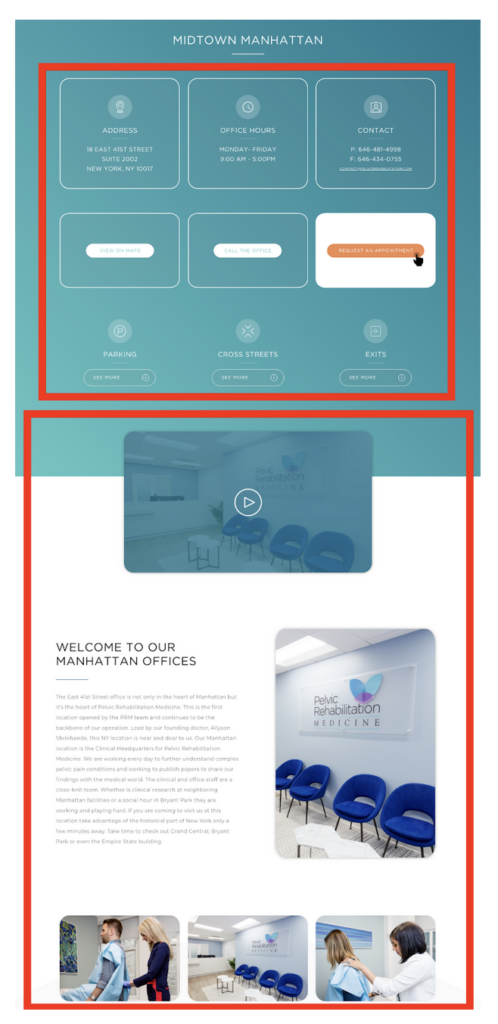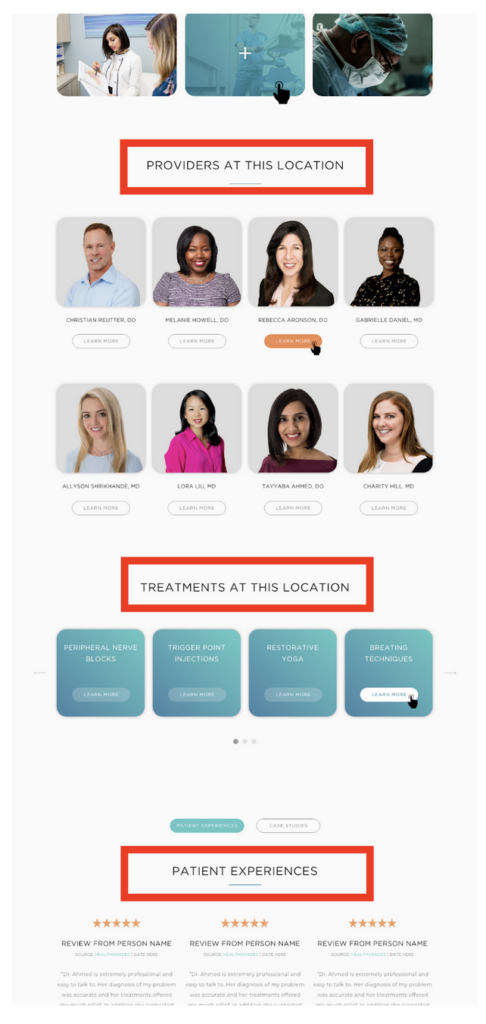Introduction: Setting the Stage for Healthcare SEO
We are always revisiting our strategic approach for our healthcare SEO efforts and attempting to find data to reinforce or alter our recommendations. Questions that are inevitably brought up to our team all center around the same thing, Where should we begin?
There are many questions that should be asked to answer that uniquely for each client and scenario. But we charge ourselves with presenting a baseline answer to that question. Something to start with and adapt on the specifics of each scenario but a foundation based on experience and data.
Analyzing the Effectiveness of Page Types
We are going on the assumption that the effective place to begin is measured against driving patient volume. As a niche agency we have the collective benefit of delivering for a specific vertical. All our clients are in healthcare, deliver some form of care and are looking to establish themselves as an authority while driving patient acquisition volume. So we are looking at that question with the lens of, what will drive the most patient volume?
The question we pose to ourselves is, ‘In what order would you sequence optimization of page types for effectiveness’ (most to least)?
Page “types” are “themes” or “groupings” of pages that fit under one category. Since all the websites we manage share an industry focus and business goal we have an overview of a large amount of relevant data. Our healthcare website development technology implements custom page types and healthcare schema. With this we are able to organize data across multiple websites into ‘like’ page “themes”. (ie – all location page data across hundreds of domains).
The main categories are listed below in order of most “valuable”. We included 4 data points. The data is from the lens of the entrance landing page and which page “type” it falls under.
- Total Traffic
- Conversion Rate
- Conversion Volume
- Bounce Rate
We ranked each page “type” from 1 to 10 in each of the 4 data points. 1 being the best and 10 being the worst. Then we took the average of the 4 rankings to create a prioritized list.
| Sessions Ranking | CR Ranking | CV Ranking | Bounce Ranking | Average | |
| Homepage | 2 | 1 | 1 | 1 | 1.25 |
| Location | 4 | 2 | 4 | 3 | 3.25 |
| Team | 5 | 4 | 3 | 4 | 4 |
| Departments | 9 | 3 | 2 | 2 | 4 |
| Conditions | 3 | 5 | 5 | 10 | 5.75 |
| Services | 6 | 6 | 7 | 7 | 6.5 |
| Admin | 7 | 10 | 6 | 5 | 7 |
| Blog | 1 | 9 | 11 | 11 | 8 |
| Insurance | 10 | 8 | 9 | 8 | 8.75 |
| Reputation | 8 | 11 | 8 | 9 | 9 |
Page Type Effort and Resource Considerations
Like any good analysis, it opened up many questions.
- How do you optimize the Homepage?
- What do these results mean for brand building?
- Is the effort to optimize each page type equal?
We attempted to try and answer these questions. We thought about the resources needed to optimize different page types. Looking at the list below we added notes on those initial questions.
Homepage Optimization: Where to Start
Reviewing our internal onboarding processes our team felt confident that we accounted for optimizing the homepage in the initial months. The schema structure built into our healthcare website development technology creates what we call a ‘central source of truth’. Starting with all the sub data each of these page types requires but the relationship between all the page types as well. (ie – which departments exist at which locations, which providers/services are offered by which department at which location.)

Attempting to bring more context to the “effort” required to optimize the different page types we added notes around the assets or work required differently of each one.
- Homepage – handled during onboarding/data gather
- Location – Ideally includes original media assets
- Team – Ideally includes original media assets
- Departments/Specialties – requires keyword research
- Conditions – requires keyword research
- Services – requires keyword research
- Admin
- Blog – requires keyword research
- Insurance
- Reputation
Optimizing Location Pages: A Deeper Look
When we look at a sample of an individual location page it gives a perfect example of where the details lie. While we ‘cover’ locations in the onboarding process, which optimizes the homepage, we are only confirming that the location exists and its relationship to the other page types. Many times projects don’t have the time and budget to fully optimize every single page within all page types. So we then create a page type prioritization that is sequentially focused on over time.
We have already confirmed a ‘Midtown Manhattan’ location exists and who the providers, services and experiences are that relate to it. But now we focus down on the individual data needed for that specific location. Medical business schema data like address, hours, phone, fax, email, parking, cross streets, exits and description are text based. But equally important is the patient experience. Photos and videos of the expected experience are preferred to be ‘fully’ optimized.


Medical Condition Pages: Different Resource Needs
Compared to a medical condition page the resources needed are very different. While supporting visuals are helpful they are not necessarily unique to the practice. These page types do require some form of keyword research and content development though. The content research is framed through attempting to fill in all the medical condition schema in a readable format.
Associated Anatomy:
The anatomy of the underlying organ system or structures associated with this entity.
- Anatomical Structure
- Anatomical System
- Superficial Anatomy
Academic Support
- Publications/Texts/Research/Etc:
Overview
- Main Medical Condition Name:
- Alternate Condition Names (Layman, Common Terms)*No limit:
Causes:
Signs or Symptoms:
Risk Factors:
Possible Treatments:
Possible Procedures:
Preventative Steps/Measures:
Additional Optional Sections:
- Risks if untreated
- Other related or parallel conditions listed out
While we have a starting place of the recommended order to optimize page types these are a few factors that need to be considered.
- Does the project have the creative resources for photos and videos?
- Does the project have the resources for research and content production?
- What is the current state of optimization for the different page types?
We then shift our focus to the non technical/on site factors. What is it that makes the homepage and location pages the most effective?
The Importance of Brand and Reputation
Looking at the homepage the immediate thought shifts to brand. The traffic is exponentially more ‘valuable’ across the board in all metrics. From traffic, conversions, conversion rate and bounce rate. While the homepage is technically optimized the ‘quality’ of the traffic being directed to it is in a better state. It reinforces the value of brand building. Where users coming directly to the homepage are often already looking for the brand, been referred to the brand, done their initial research to come across the brand, been exposed to reputation for the brand and many other brand related scenarios.
The reputation piece starts to extend to the location page type as well. As businesses with brick and mortar locations that serve customers there are numerous review platforms that can be leveraged. Think google business profiles, Vitals, bing places, etc. When those profiles are optimized correctly (linking to the relevant individual location URL) and you have established a positive reputation the users landing on locations pages first are often primed already to be more ‘valuable’ traffic.
While it is important to have a healthcare marketing agency that understands the industry, has a strategic approach to delivery, there are numerous factors that need to be considered within each project to ensure it is being delivered the most effective way possible.
